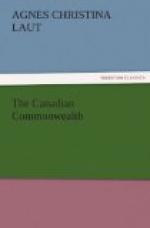“I regret,” said a judge in a Winnipeg court, “to sentence such a youthful offender.” The prisoner was a young foreigner who attacked another man viciously in a drunken brawl. “But foreigners must learn that Canadian law can not be broken with impunity,” and he sent the young man to what was practically a life sentence.
“Hard on the poor devil,” said a court attendant.
“Yes,” retorted a westerner who lived in the foreign settlement, “but it’s an all-fired good thing for Canada.”
The case of a judge in British Columbia is famous on the Pacific Coast. It was in the old days of murder and robbery on the trail to the gold diggings of Cariboo. In the face of the plainest evidence the jury had refused to convict. The astounded judge turned amid tense silence in fury on the prisoner.
“The jury pronounces the prisoner not guilty,” he said, “and I strongly recommend him to go out and cut their throats.”
Reference has been made to an Imperial court official assassinated by an angry Hindu conspirator in a Vancouver court room. The assassin was sentenced to death nine days from the commission of the crime, and if any newspaper had attempted to make a head-line affair out of it, or “to try the jury” for trying the prisoner, the editors and owners of that paper would have been sent to jail for contempt.
IV
The gradual rise of the two political parties dates from the adoption of a high tariff by the Conservatives after confederation. Prior to 1837 Canadian parties consisted simply of the Outs and the Ins. The advanced Radicals, who formed themselves into a party to oust the Family Compact, called themselves Liberals. The entrenched oligarchy called themselves Conservatives. After confederation, by force of circumstances, namely the refusal of tariff concessions from the United States, the Conservatives, who were in power, became the high tariff party. The Liberals, when out of power, advocated tariff for revenue only. Also by force of circumstances until the transfer of the balance of power from Quebec to the New West, the party in office had a tendency to play for the French Catholic vote of Quebec; the party out of office coquetted with the ultra-Protestant vote of Ontario. This naturally worked toward the provincial governments being Liberal, when the federal government was Conservative; and vice versa. The Liberal in provincial politics was Liberal in federal politics, and the Conservative in federal politics was Conservative in provincial politics; but the policy has always been for the Outs first to attack the Ins provincially—to win the outposts before attacking the entrenched power of the federal government. Before Sir John Macdonald’s Conservative administration was defeated there was a long series of victories by the Liberals in the provinces, and before Sir Wilfred Laurier’s Liberal government was defeated the




